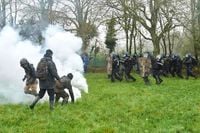On Tuesday, April 22, 2025, a significant operation took place at the former Zone à Défendre (ZAD) of Notre-Dame-des-Landes, where gendarmes and CRS (Compagnies Républicaines de Sécurité) expelled the last seven occupants from the site. This action was executed on state-owned land, where the individuals had been living illegally for nearly a decade, engaging in self-management and community projects.
The evacuation occurred early in the morning at approximately 6:45 AM, under a heavy police presence. According to the Loire-Atlantique prefecture, the operation was necessitated by a formal notice issued by a bailiff, which prompted the occupants to vacate the property peacefully. However, one individual was placed in a sobering-up cell due to intoxication during the intervention.
The prefecture indicated that the occupants were offered emergency accommodation for several nights and professional reorientation appointments. Despite these offers, only one individual expressed interest in relocation, while the others opted to leave for nearby fields.
The site, known as La Grée, had been a hub for various community initiatives, including the preparation for a rap studio project. The occupants were gearing up to celebrate the tenth anniversary of their presence on the site on May 24, 2025. However, this event is now set to transform into a demonstration aimed at reoccupying the area.
The association NDDL Poursuivre ensemble, which has historically opposed the airport project, condemned the expulsions as "completely arbitrary and forced." They criticized the decision to demolish the farm on site, labeling it a "gratuitous and unnecessary" action against a structure that has been integral to local agricultural efforts.
In a statement, the prefecture highlighted the severe health and safety risks posed by the site, which had been identified during a February 2025 inspection. This assessment involved the gendarmerie, the French Office for Biodiversity (OFB), an electricity company, and the Departmental Fire and Rescue Service. The inspection revealed numerous unauthorized electrical connections, makeshift sanitary facilities, and significant environmental degradation.
According to the OFB, the site displayed "extreme unsanitary conditions," with twelve waste deposit zones, eight vehicle carcasses, nine caravans (six of which were in advanced degradation), and two open-air sanitation discharge zones. These conditions not only posed a risk to human health but also threatened the surrounding natural environment.
The prefecture noted that the presence of human waste in ditches raised concerns about potential surface water pollution, further emphasizing the necessity of the evacuation.
This operation is not isolated; it follows a previous significant intervention in November 2024, when authorities demolished a dilapidated building on the same site, removing 18 tons of waste and 4.5 tons of scrap metal. Despite the abandonment of the airport project in 2018, the lands of the former ZAD have seen a resurgence of activism, with new generations of environmentalists and alter-globalization activists reoccupying parts of the area, leading to tensions with local residents.
The complexity of the situation at Notre-Dame-des-Landes is further compounded by the fact that the majority of the land is now managed by the Department, which has begun offering long-term leases to regularize agricultural installations. However, many occupants remain resistant to these arrangements, reflecting ongoing conflicts between activist ideals and regulatory requirements.
As the dust settles from this latest eviction, the future of La Grée remains uncertain. The site, once a stronghold for anti-airport protests, now finds itself at the intersection of community activism, environmental concerns, and state intervention. The upcoming anniversary demonstration is expected to draw attention to these ongoing struggles and the broader implications for land use and community rights in the region.
In summary, the evacuation of the ZAD at Notre-Dame-des-Landes marks a significant moment in the ongoing narrative of land occupation and environmental activism in France. With the state's firm stance on safety and environmental concerns, the fate of the site hangs in the balance as former occupants and their supporters rally to reclaim their space.





